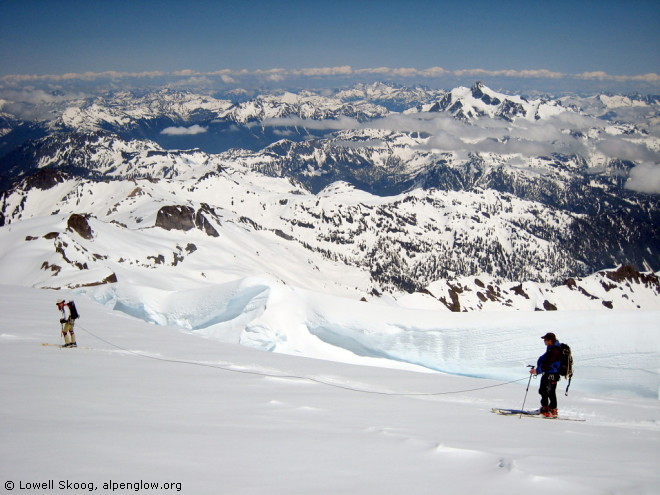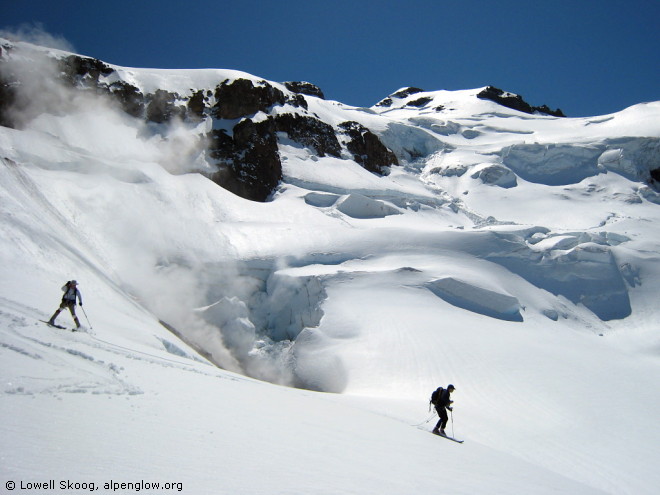Part 6 - Glaciers
Crevasse accidents involving skiers are almost unheard of in the Cascades.
Yet a rash of incidents occurred in the spring of 2008. What happened?
What can we learn from this?
Typical Glacier Skiing Practices
- Cascade skiers sometimes rope up on glaciers for ascents and
traverses (though I suspect that most of the time they don’t.)
- Cascade skiers rarely rope up for glacier descents.
- Despite these casual practices, there have been very few incidents
that I’ve heard of in the past 25+ years.
- I don’t know of any confirmed fatalities from skiers falling
into crevasses during that time.
2008 Glacier Skiing Incidents
- April 26, Mt Shuksan, White Salmon Glacier — A skier
who was skinning up the glacier pitched forward into a hidden crevasse
and found himself partially dangling over the abyss. Fortunately he was
able to roll to the side to free himself.
- April 26, Mt Baker, Coleman Glacier — Kevin LeFleur
disappeared during a ski ascent of Mt Baker. We don’t know what
happened to him, but considering that he was not found during the
following summer, it seems plausible that he may have fallen into a
crevasse.
- May 4, Mt Rainier, Nisqually Glacier — A skier
descending obliquely from Camp Muir toward the Wilson Glacier stopped on a
hidden crevasse, which collapsed and sent him falling 80 feet head-first.
He came to a stop wedged in the crevasse and his partners, with the help of
the Camp Muir rangers, pulled him out.
- May 6, Ripsaw Glacier, B.C. — A skier traversing the
upper Ripsaw Glacier on the Spearhead Traverse in British Columbia fell
30 feet into a bergshrund and was later saved by a search and rescue team.
2008 Incidents, Common Factors
- Spring 2008 was unusually cold and snowy.
- All the incidents were on glaciers with recent fresh snow that
masked the existence or size of the crevasse.
- The incidents involved skiers moving largely parallel to the
crevasse (across the slope).
- All the skiers were unroped.
Suggestions For Glacier Skiing
- Always wear a harness and carry rescue rope and gear on a glacier.
- If you hope to save time by not roping, consider carrying two ropes in
the party in case a skier carrying one of the ropes falls into a crevasse.
If you have just one rope, it should be carried by the last skier in line
and he/she should follow the tracks of the lead skier(s).
- The most important consideration for deciding whether to rope up is
the consistency and recent history of the snow. Fresh, soft snow
(especially wind-deposited snow) masks crevasses at the same time it
creates weak bridges.
- The nature of the snow is more important than the appearance of
crevasses, because as the 2008 incidents showed, if there is fresh snow,
you may not even know a crevasse is there.
- Fresh, soft snow argues for roping; old, hard snow argues against
roping (because of the risk of not being able to stop a slide on skis).
You have to make a judgment to balance the risks.
- If you’re concerned about crevasses, but the snow is firm
enough that you’re not sure you can stop a slip with skis on,
it’s okay to rope up, take your skis off, and grab an ice axe!
Example: Mt Baker High-Level Orbit
- My June 2008 orbit of Mt Baker was done at a time when the recent
spring crevasse incidents were fresh in our minds.
- The picture below shows us traversing the Deming Glacier on the SW
side of Mt Baker in the morning. There were some very large crevasses
nearby, but the snow was hard and bulletproof.
- We reasoned that 1) the snow bridges were very strong, and 2) if we
roped up it would be very difficult to stop a fall if somebody on the
rope went into a crevasse.
- So we stayed unroped and used ski crampons.

|
 |
|
David Perez, Brian Smith and Ross Freeman ski unroped across
the well-frozen Deming Glacier on Mt Baker, June 2008.
|
 |
- Later that day, as we rounded the mountain to the SE and east facing
Boulder and Park Glaciers, the snow changed dramatically. It was much
softer because of sun warming.
- We put the rope on (photo below), not only because the chance of
punching into a crevasse seemed higher but also because the chance of
stopping a fall was higher.

|
 |
|
Ross Freeman and Benj Wadsworth traverse the sun-softened Park
Glacier on Mt Baker, June 2008.
|
 |
- As we crossed onto the Mazama Glacier we did some roped downhill
skiing (photo below). Most backcountry skiers seem to think that roped
skiing is awful. But I think if you slow down and take your time, it is
one of the under-appreciated pleasures of ski mountaineering. Roped
skiing needn’t be slapstick—it can be a graceful minuet.

|
 |
|
Benj Wadsworth and Ross Freeman ski roped near the Dorr Fumaroles,
Mazama Glacier, Mt Baker, June 2008.
|
 |
Conclusions
- Ski safe.
- Ski far.
- Have fun!
<<Prev
|
Intro
|
Timing
|
Winter
|
Mush
|
Gliding
|
Weather
|
Glaciers
|
Next>>

|




